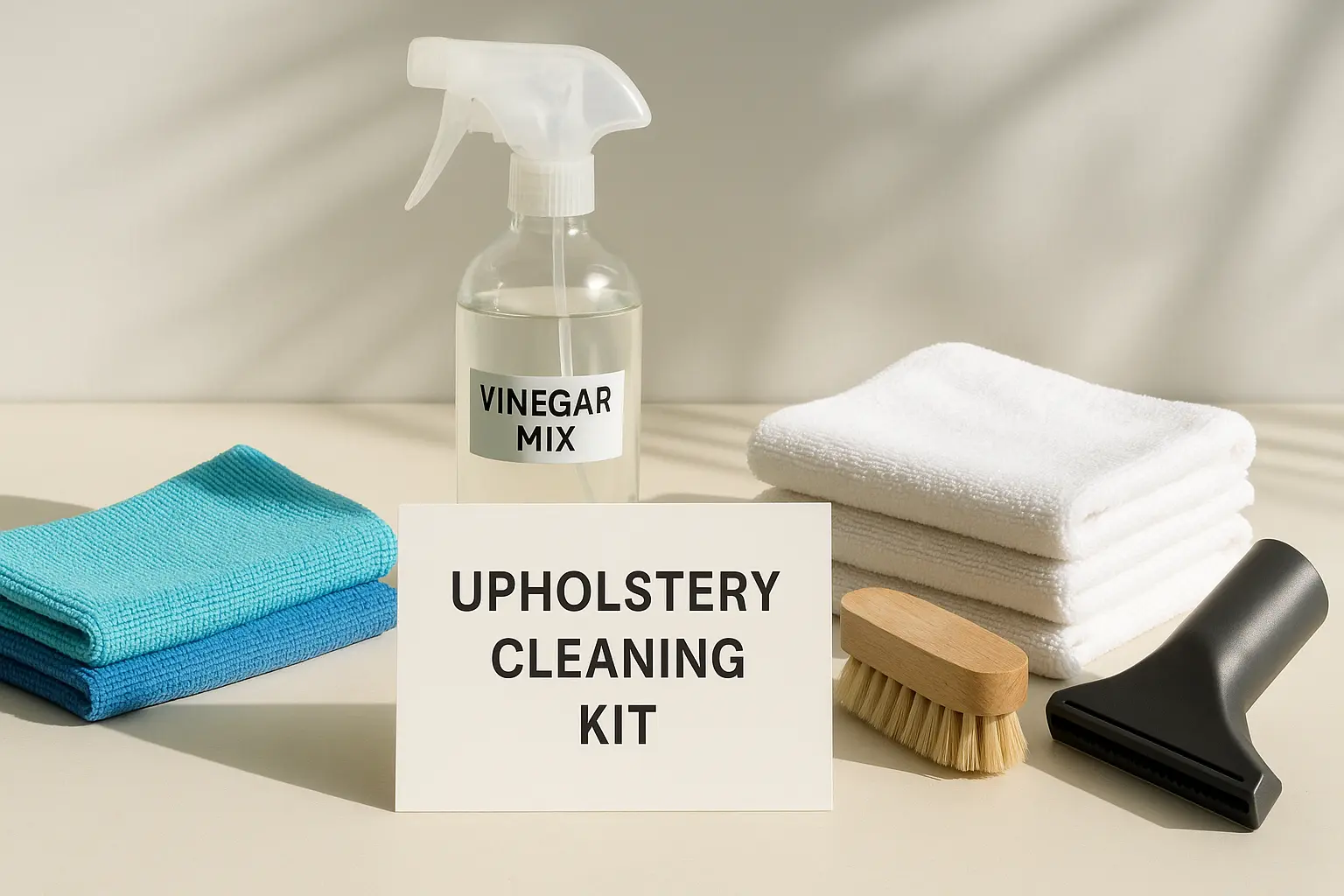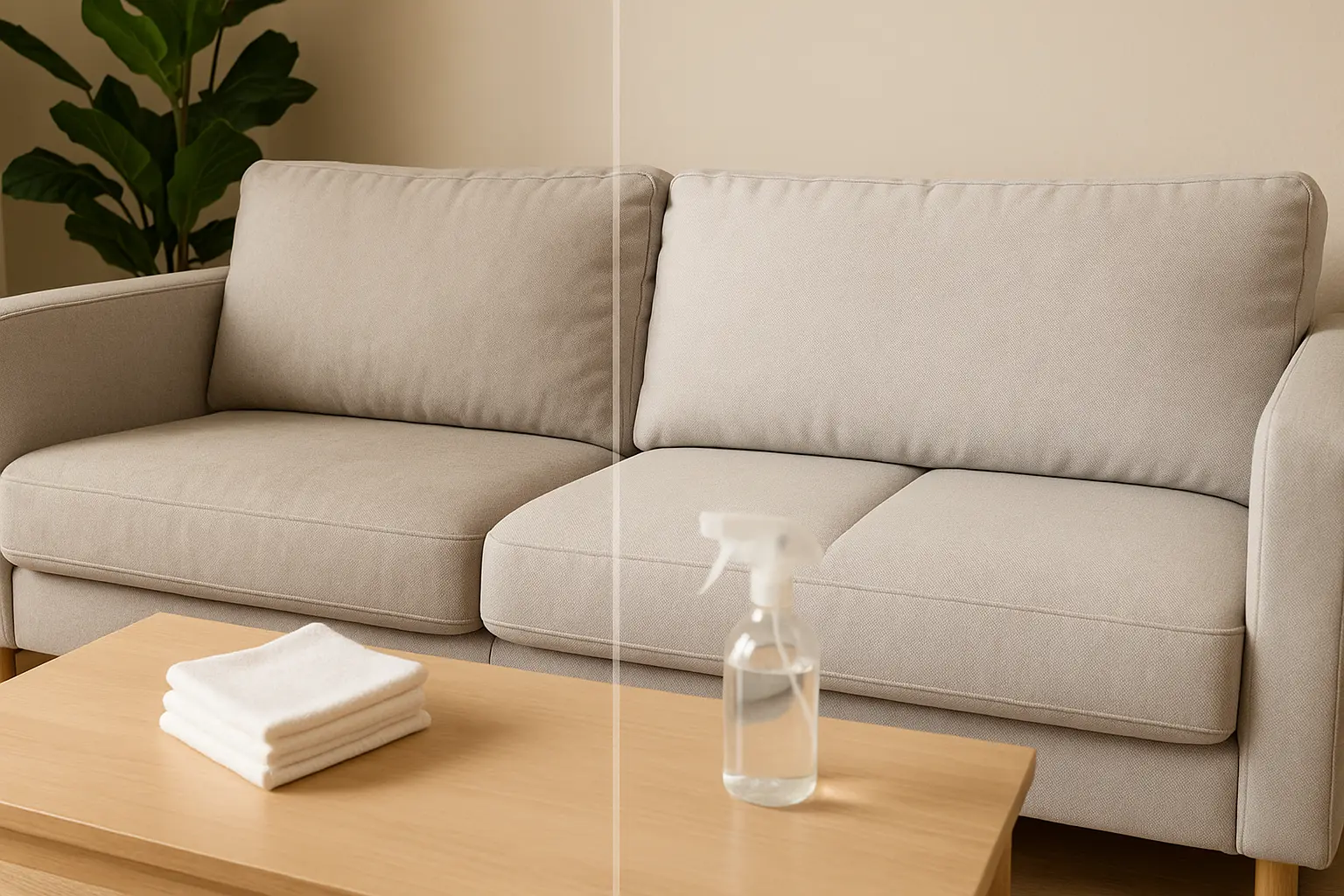
Spills, paw prints, and mystery smudges don’t have to mean a pricey store run. With two pantry staples and five minutes, you can lift odors, loosen grime, and make your sofa look “company ready” again—our Homemade Cleaning Solution for Upholstery: 2-Ingredient Formula That Works is literally just vinegar and clear dish soap. For the full house-wide playbook, see our homemade cleaning solutions guide—it’s the hub that ties every room together.
Try Our Fabric Checker!Table of Contents
- Key Takeaways for a Cleaner Sofa (Fast)
- Why This 2-Ingredient Sofa Cleaner?
- Know Your Upholstery: Fabric Types and Care
- Two Quick At-Home Mixes
- Essential Tools You’ll Need
- Spot Test: A Must-Do Step
- Upholstery Deep-Clean: Step-by-Step Guide
- Troubleshooting Upholstery Cleaning Challenges
- Homemade vs. Store-Bought Cleaners
- Upholstery Fabric Checker Tool
- Maintaining Your Upholstery’s Freshness
- Frequently Asked Questions
- Final Thoughts on a Cleaner Home
Key Takeaways for a Cleaner Sofa (Fast)
- Simple & Effective: Mix a simple two-ingredient upholstery cleaner (vinegar + clear dish soap), or use baking soda for deodorizing.
- Fabric First: Identify your upholstery fabric (e.g., microfiber, linen) and spot-test in a hidden area before cleaning.
- Essential Tools: Use a microfiber cloth, spray bottle, and a soft-bristle brush for effective upholstery care.
- Cost & Safety: Homemade solutions are affordable and free from harsh chemicals, ideal for families and pets.
- Patience Pays Off: Let upholstery air dry completely to avoid water rings or musty odors.
Why Choose a Homemade Cleaning Solution for Upholstery?
Before grabbing a store-bought spray, consider why a DIY upholstery cleaner recipe is often the better pick. For instance, it’s super cost-effective. I love that my DIY sofa cleaner uses stuff I already have in my pantry, like vinegar and dish soap, saving me a ton of cash over time. You can explore budget-friendly cleaning tips to stretch your dollar further.
Moreover, I get to control the ingredients. Store-bought cleaners often have weird, unpronounceable chemicals that make me nervous, especially with my dog and kids around. With a natural sofa cleaner like vinegar and dish soap, I know exactly what’s going on my furniture, keeping things safe and worry-free. This is especially handy if you’re trying to keep pet care costs low while keeping your home safe for furry friends. For more safe cleaning inspiration, check out Real Simple’s expert guide on upholstery cleaning.
Using ingredients you trust makes your home feel safer and cozier.
Plus, these solutions are versatile. They handle everything from dirt to pet messes, and I can adjust the mix based on the stain. This natural cleaning method is affordable, safe, and works wonders on everyday messes.
It’s the kind of solution that makes you feel like a cleaning pro without breaking the bank!

Know Your Upholstery: Fabric Types and Care
Before you whip up your homemade cleaning solution for upholstery, you’ve got to know your furniture’s fabric. Using the wrong cleaner can mess up your sofa with stains or damage, so always check the care tag, usually tucked under a cushion or on the frame. This is key whether you’re cleaning or decorating on a budget.
Fabric Care Codes
- W: Water-based cleaners (like our DIY recipe) are safe.
- S: Solvent-based cleaners only; avoid homemade water-based solutions.
- WS: Water or solvent-based cleaners work, but spot-test first.
- X: Vacuum only; no liquids allowed.
Common Upholstery Fabrics
- Microfiber: Tough, stain-resistant, usually “W” or “WS.” Perfect for our natural upholstery cleaning solution.
- Linen/Cotton: Comfy but can get water rings; use just a little moisture and spot-test.
- Synthetics (Polyester, Nylon): Strong, often “W” or “WS,” great for DIY cleaning.
- Velvet/Chenille: Synthetic velvet might be water-safe; natural velvet usually needs a pro.
- Silk/Rayon: Super delicate, often “S” or “X”; skip homemade cleaners.
- Leather/Suede: Needs special cleaners, not our solution.
- Antique Furniture: Tricky and delicate; I’d call a professional to keep it safe.
If you can’t find the tag (like when I lost mine under the couch!), take it slow and do a spot test.
Two Simple Upholstery Cleaner Recipes (At Home)
Now that you’ve got a handle on your fabric, let’s jump into two easy ways to mix an at-home upholstery cleaner. Both take only a few minutes, lift real grime, and won’t blow your budget.
Recipe 1: Vinegar & Dish Soap Cleaner
This quick mix is my go-to for daily spills on water-safe fabrics such as microfiber or most synthetics.
Ingredients:
- White vinegar: its mild acidity loosens stains and odors.
- Clear dish soap: cuts grease and sticky spills (I use Dawn).
- Warm water: thins the mix so it sprays evenly.
- Spray bottle: lets you mist instead of soaking the fabric.
Instructions:
- Pour warm water into a clean spray bottle until it’s about two-thirds full.
- Stir in 1/4 cup white vinegar.
- Add 1 tablespoon clear dish soap.
- Swirl gently to combine—no hard shaking, or you’ll make foam.
Why It Works: Vinegar’s mild acidity loosens residue, and the soap breaks up oils so messes wipe away instead of smearing.
Best For: Everyday spills, snack drips, pet funk, and quick all-over freshening.
Recipe 2: Baking Soda Odor Eliminator
When the couch smells off, this two-ingredient upholstery cleaner is my go-to—simple to use and it clears odors fast.
Ingredients:
- Baking soda: absorbs smells and loosens light soil.
- Vacuum cleaner: use the upholstery tool for better pickup.
- Optional essential oil: a few drops for scent (I like lavender).
Instructions:
- Dust a light layer of baking soda over the fabric.
- Optional: stir 5–10 drops of essential oil into 1 cup of baking soda first.
- Let it sit 30 minutes (overnight for tough odors).
- Vacuum thoroughly to pull up the powder and trapped smells.
Why It Works: Baking soda acts like a sponge for bad smells and gently scrubs away light stains, making the job a breeze.
Best For: Pet odors, fresh spills, or a quick refresh before a deeper clean.

Essential Tools for This Upholstery Cleaner
The right tools do most of the work for you. Here’s the short list I actually reach for—it keeps costs low and results high, much like any good budget-friendly family routine:
- Microfiber cloths: grab a few—great for blotting, lifting dust, and gentle scrubbing with your natural upholstery cleaner.
- Spray bottle: helps you mist the solution evenly instead of soaking areas.
- Soft-bristle brush: lifts stubborn dirt without roughing up the fabric.
- Vacuum with upholstery attachment: clears away loose debris first.
- White towels: for blotting and checking if colors bleed.
With the right tools, your DIY approach works like the pros—without the price tag.
Spot Test: A Must-Do Step
Before you spray your DIY cleaner, a quick spot test is essential to avoid any disasters. Here’s the deal:
- Choose a hidden spot: think under cushions or behind the frame.
- Apply solution: dampen a white microfiber cloth with the solution and dab gently.
- Check for issues: look for color transfer or any texture change after drying.
- Wait: let the spot dry fully (a few hours) to be sure no water rings appear.
If you see color transfer or the texture changes, stop. Calling a pro usually costs less than fixing damage later.
DIY Upholstery Cleaning: Step-by-Step Guide
Once the test spot dries clean, grab your mix and get going. Follow this simple flow for reliable results:
Step 1: Pre-Clean
- Vacuum slowly with the upholstery tool, getting into seams and crevices.
- Remove cushions so you can clean all sides and the frame.
Step 2: Optional Baking Soda Treatment
- Sprinkle baking soda lightly, let it sit for 30 minutes, then vacuum.
Step 3: Apply Your Two-Ingredient Upholstery Cleaner
- Mist a small section lightly with the vinegar-based upholstery cleaner.
- Blot with a microfiber cloth or gently scrub stains with a soft brush, working from outside to center.
Step 4: Blot and Rinse
- Blot with a dry microfiber cloth to lift dirt.
- Optional: blot with a water-dampened cloth to remove soap residue.
- Work in sections, swapping out dirty cloths as needed.
Step 5: Dry Thoroughly
- Let it air dry completely (several hours) to avoid mildew.
- Use fans or open windows to speed things up.
- Brush dry fabric to restore softness.
Troubleshooting Upholstery Cleaning Challenges
Run into trouble? Here’s how to fix common issues when you use this upholstery cleaner:
- Stubborn stains: reapply the DIY cleaner or try a baking soda paste. For light fabrics, a diluted hydrogen peroxide mix (1:2 with water) can help, but spot-test first.
- Water rings: mist the whole area with water, blot well, and dry evenly with fans.
- Odors: sprinkle more baking soda overnight or place activated charcoal nearby.
- Stiff fabric: gently brush or vacuum to soften it up.
Homemade vs. Store-Bought Cleaners
| Feature | DIY Upholstery Cleaner (Homemade) | Store-Bought Spray |
|---|---|---|
| Cost | Low; uses pantry staples. | Moderate to high. |
| Ingredients | Natural, non-toxic (vinegar, soap). | Often synthetic chemicals. |
| Effectiveness | Great for common stains on water-safe fabrics. | Varies by brand; some target specific stains. |
| Safety | Safe, low fumes. | May irritate skin or lungs. |
| Environmental Impact | Low waste, biodegradable. | Plastic waste, less eco-friendly. |
Upholstery Fabric Checker Tool
Not sure if your furniture can handle this upholstery cleaner? This quick tool checks compatibility in seconds.
Maintaining Your Upholstery’s Freshness
To keep your furniture looking fresh using a simple DIY upholstery cleaner, adopt these simple habits, much like sticking to a budget with affordable meal planning:
- Regular Vacuuming: Weekly vacuuming stops dirt from settling in.
- Quick Spill Response: Blot spills right away to prevent stains.
- Rotate Cushions: Flip them to even out wear.
- Protect from Sunlight: Use curtains to avoid fading.
- Use Throws: Washable covers make cleaning easier.
- Avoid Moisture: Use minimal liquid and dry thoroughly.
- Professional Cleaning: Schedule every 1–3 years for a deep clean.

Frequently Asked Questions
Final Thoughts on a Cleaner Home
Cleaning your furniture with a DIY furniture cleaner can be surprisingly satisfying. A simple 2-ingredient mix and a microfiber cloth go a long way without harsh chemicals or a big bill. Know your fabric, spot-test, and blot gently with your DIY cleaner—you’ll end up with a fresher, cozier sofa.
For more eco-friendly cleaning ideas, dive into our foundational resource, the Guide to Homemade Cleaning Solutions, to keep your entire home sparkling on a budget.
Disclaimer: Always check your upholstery’s care guidelines and perform a spot test before using any homemade cleaning solution. These tips are for informational purposes only and may not be suitable for delicate fabrics like silk or antique upholstery. Consult a professional for specialty materials.